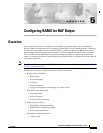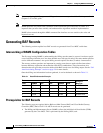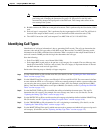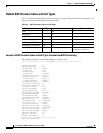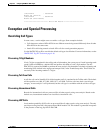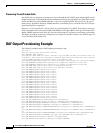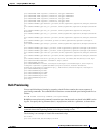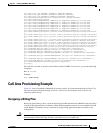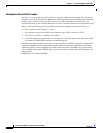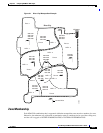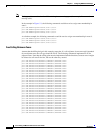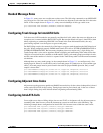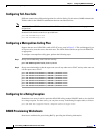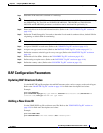
5-3
Cisco Billing and Measurements Server User’s Guide
OL-3351-01
Chapter 5 Configuring BAMS for BAF Output
Identifying Call Types
Note The prefix of the files polled by the POL task is the input prefix for FMT, the initial
processing task. Changing the parameter file-prefix1 or file-prefix2 in the Poll table
automatically changes the input prefix of the FMT task. This change takes effect on the
next startup of the system.
2. BAMS correlates the CDBs into a merged call structure. This is performed by the Correlation (COR)
task.
3. Each call type is categorized. This is performed by the Augmentation (AUG) task. The AUG task is
involved in the output of BAF records, as well as the BAF-to-CDR conversion task (CTB).
4. The ASCII Conversion (ASC) task outputs Cisco MGC End of Call 1110 ASCII files.
Identifying Call Types
Identification of call-type information is key to generating BAF records. The call type determines the
structure code and the call-type tables of the BAF record. Because the Cisco MGC generates partial
information in the CDBs, additional data within the CDBs is required for the unique identification of
each call scenario. BAMS provides the logic that determines the call type.
Note the following:
• Each Cisco MGC serves a set of home NPA-NXXs.
• Each output BAF record needs to be put into a call category (for example, Flat rate, Message rate,
IntraLATA, InterLATA, Toll-Free, and so forth). The call category is important because it dictates
the BAF structure code and call-type fields.
Perform the following steps to identify call-type categories:
Step 1 Use the ZONE-INFO tag ID to define zone IDs. (For details, see the “Updating the Zone Information
Table” section on page 4-29.)
Step 2 Use the NPANXX tag ID to assign a zone ID and a LATA to each NPA-NXX. The zone narrowly defines
an area within the LATA as a call category. LATAs are centrally managed, and the system assumes that
you are using the correct source for the population of the LATA (for example, using Bellcore LERG
tables). Note that the LERG tables are not part of BAMS. (For details, see the “Updating the NPANXX
Table” section on page 4-13.)
Step 3 Use the RATING-TYPE tag ID to establish the calling relationships between zones. This tag ID
determines the call category (for example, flat rate, message rate, and so on). (For details, see the
“Updating the Rating Type Table” section on page 4-16.)
Step 4 Use the RATE-EXC tag ID to override certain call-category relationships defined with the NPANXX tag
ID. (For details, see the “Updating the Rating Exception Table” section on page 4-16.)
Step 5 Use the TRUNKGRP tag ID to determine if a call is originating or terminating. (For details, see the
“Updating the Trunk Group Table” section on page 4-26.)
Step 6 Use the MAPTYPE tag ID to specify which structure code to generate and which call type to assign each
call category. (For details, see the “Updating the Map Type Table” section on page 4-4.)



